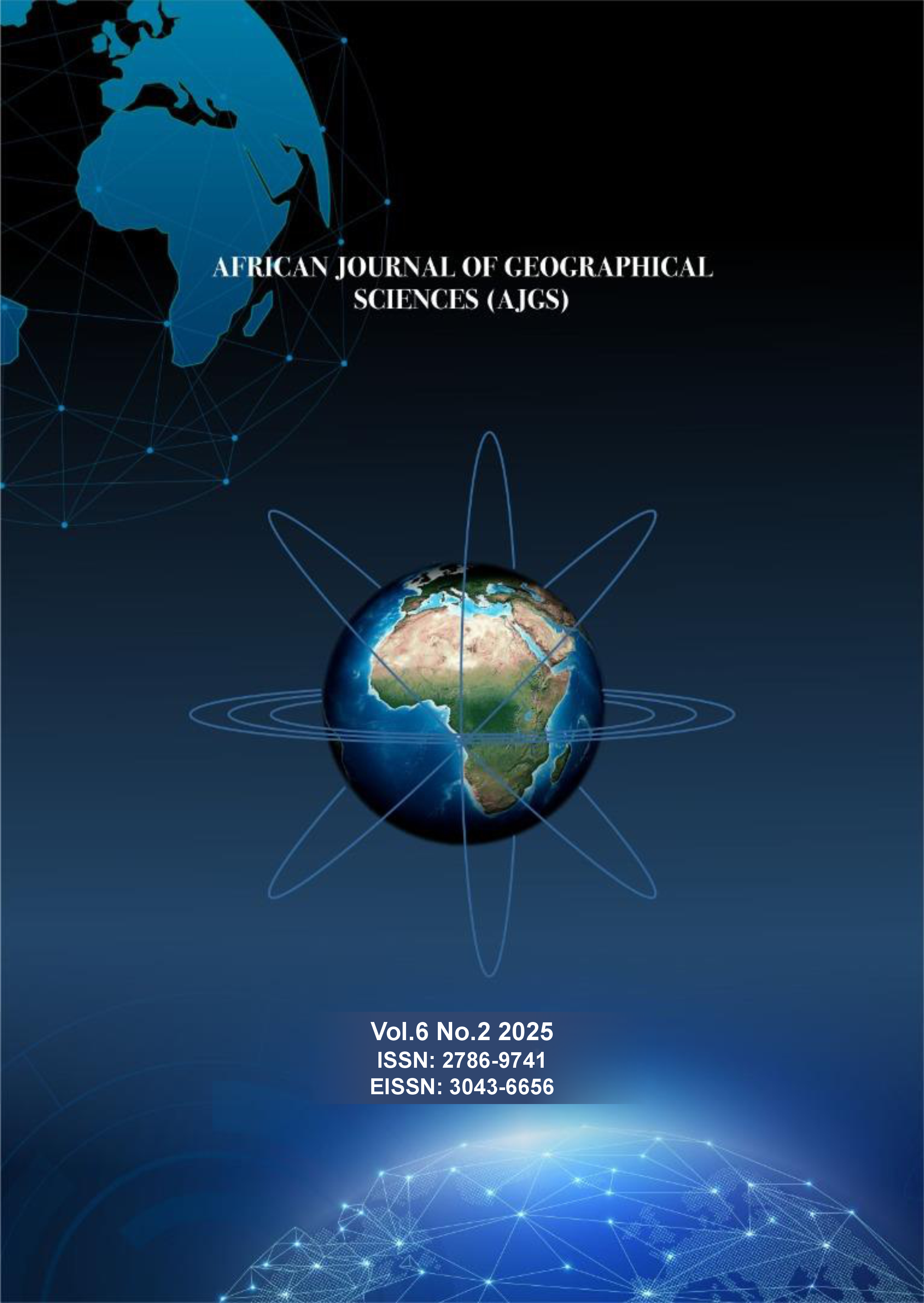DYNAMICS AND SOCIOECONOMIC IMPACT OF RICE CULTIVATION IN THE ETSAKO REGION, EDO STATE, NIGERIA
Contenu principal de l'article
Résumé
This study investigated the spatial patterns and socioeconomic implications of rice farming in Etsako, Edo State, Nigeria, addressing two research questions: What is the spatial pattern of rice cultivation in the study area, and what are its socioeconomic implications for farmers? Employing a mixed-methods approach, data was collected from 328 rice farmers across Etsako West, East, and Central Local Government Areas using a two-stage sampling technique (purposive and systematic random sampling). Six communities in which rice was predominantly cultivated were purposively selected, then systematic random sampling was applied to select rice farmers within these communities and semi-structured questionnaires. Descriptive and inferential statistics, supported by the Livelihoods Framework, were used to analyze farm sizes, planting seasons, climate impacts, income, expenditure, and how earnings meet farmers’ needs (education, health, housing, food, clothing). Key findings reveal that most farmers (81.7%–88.7%) cultivate 1–2 hectares, with a slight increase in 3–4 hectares by 2017, driven by improved inputs. Two planting seasons dominated (81.0%), limited by rainfed systems, while rainfall (45.1%) and humidity (52.4%) significantly affect production. Income was substantial (59.5% earn above N300,000), but high losses (181 farmers) and moderate expenditure (68.6% spend N51,000–N100,000) reflect financial constraints. Earnings adequately met food (mean = 3.78) and clothing (mean = 3.53) need but fell short for education (mean = 2.59) and health (mean = 2.75). The study recommends the development of small-scale irrigation systems to extend planting seasons, strengthening extension services for climate-smart practices, and providing low-interest loans to enhance profitability and meet non-essential needs. These findings benefit farmers, policymakers, and extension officers by informing targeted interventions to boost productivity, reduce losses, and improve livelihoods, contributing to sustainable agricultural development in Etsako.
Details de l'article
Références
Bhatta, G. D., and Doppler, W. (2011). Spatial distribution of farm-family resources in the mid-hills of Nepal. Asian Journal of Agriculture and Development, 8(2), 29–41.
Emenekwe, C. C., Onyeneke, R. U., and Nwajiuba, C. U. (2022). Assessing the combined effects of temperature, precipitation, total ecological footprint, and carbon footprint on rice production in Nigeria: A dynamic ARDL simulations approach. Environmental Science and Pollution Research, 29(56), 85005–85025.
FAOSTAT. (2020). Food and agriculture data. Food and Agriculture Organization of the United Nations. http://www.fao.org/faostat/en/#data
Akande, S. O., Olorunfemi, I. E., and Adeyemi, A. A. (2021). Trends and spatial analysis of temperature and rainfall patterns on rice yields in Nigeria. Academia.edu.
Awotide, B. A., Awoyemi, T. T., and Oluwasanya, G. (2016). Agricultural technology adoption, commercialization and smallholder rice farmers’ welfare in rural Nigeria. Agricultural and Food Economics, 4(1), 3. https://doi.org/10.1186/s40100-016-0047-8[](https://agrifoodecon.springeropen.com/articles/10.1186/s40100-016-0047-8)
Bhatta, G. D., & Doppler, W. (2011). Spatial distribution of farm-family resources in the mid-hills of Nepal. Asian Journal of Agriculture and Development, 8(2), 29–41.
Emenekwe, C. C., Onyeneke, R. U., and Nwajiuba, C. U. (2022). Assessing the combined effects of temperature, precipitation, total ecological footprint, and carbon footprint on rice production in Nigeria: A dynamic ARDL simulations approach. Environmental Science and Pollution Research, 29(56), 85005–85025.
Kamba, A. A., and Adamu, A. K. (2021). Children involvement in rice cultivation: Assessment of their role and impact in Sokoto State, Nigeria. Academia.edu.
Ojo, M. A., and Adebayo, P. A. (2019). Analysis of rice production in Edo State, Nigeria: Implications for food security. Journal of Agricultural Extension, 23(3), 45–53.
Omonona, B. T., Oyinbo, O., and Obisesan, A. A. (2021). On spatially dependent risk preferences: The case of Nigerian farmers. Sustainability, 13(11), 5942. https://doi.org/10.3390/su13115942[](https://www.mdpi.com/2071-1050/13/11/5943/htm)
Saito, K., Dieng, I., Toure, A. A., and Somado, E. A. (2019). Challenges and opportunities for improving N use efficiency for rice production in sub-Saharan Africa. Plant Production Science, 22(2), 123–135. https://doi.org/10.1080/1343943X.2018.1544466[](https://www.tandfonline.com/doi/full/10.1080/1343943X.2019.1617638)
Senthilkumar, K., Tesfaye, A., and Saito, K. (2023). Status quo and challenges of rice production in sub-Saharan Africa. Knowledge for Policy. https://doi.org/10.2760/72301[](https://www.tandfonline.com/doi/full/10.1080/1343943X.2023.2241712)
Zossou, E., Saito, K., Imorou, A. A., Ahouanton, K., and Tarfa, B. D. (2021). Participatory diagnostic for scaling a decision support tool for rice crop management in northern Nigeria. Development in Practice, 31(1), 11–26. https://doi.org/10.1080/09614524.2020.1770699[](https://www.tandfonline.com/doi/full/10.1080/1343943X.2023.2241712)
Adeyemo, T. A., and Olajide, O. A. (2022). Spatial analysis of agricultural land use and productivity in Nigeria: A case study of Oyo State. Journal of Rural Studies, 95, 123–134. https://doi.org/10.1016/j.jrurstud.2022.08.012
DFID. (1999). Sustainable livelihoods guidance sheets. Department for International Development. https://www.livelihoodscentre.org/documents/20720/100145/Sustainable+livelihoods+guidance+sheets/1f67d3b7-4b60-4b78-aef7-6c3323a3b4e4
Ellis, F. (2000). Rural livelihoods and diversity in developing countries. Oxford University Press.
Nwali, C. S., Amadi, P. E., and Onyeneke, R. U. (2024). Socioeconomic determinants of market participation among rice farmers in Southeast Nigeria. African Journal of Agricultural Research, 20(2), 87–98. https://doi.org/10.5897/AJAR2023.16432
Ogundipe, A. A., Ogunniyi, A. I., and Olagunju, K. O. (2023). Climate change adaptation and rice productivity: Evidence from smallholder farmers in Nigeria. Climate and Development, 15(4), 321–335. https://doi.org/10.1080/17565529.2022.2090623
Aigbokhan, E. I., & Alufohai, G. O. (2022). Agricultural land use and environmental sustainability in Edo State, Nigeria. Journal of Environmental Management and Tourism, 13(3), 712–722. https://doi.org/10.14505/jemt.v13.3(59).10
Egharevba, R. K., Omoregie, C. K., & Imoobe, T. O. (2023). Climate variability and its impact on agricultural productivity in northern Edo State, Nigeria. African Journal of Climate Studies, 5(1), 45–56. https://doi.org/10.1080/23744731.2022.2145678
Ojeifo, M. O., & Okhakhu, P. A. (2020). Historical geography and socio-cultural dynamics of Etsako Region, Edo State, Nigeria. Journal of Nigerian Historical Studies, 12(1), 23–34.
Dantata, N. S., and Mohammed, A. (2019). Rice (Oryza sativa L.) production in Nigeria: Challenges and prospects. Retrieved from ResearchGate: https://www.researchgate.net/publication/338010676_Rice_Oryza_Sativa_L_Production_in_Nigeria_Challenges_and_Prospects
Kamai, N., Omoigui, L. O., Kamara, A. Y., & Ekeleme, F. (2020). Guide to rice production in Northern Nigeria. Ibadan, Nigeria: International Institute of Tropical Agriculture. Retrieved from https://www.iita.org/wp-content/uploads/2020/07/Guide-to-Rice-Production-in-Northern-Nigeria.pdf
